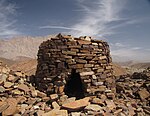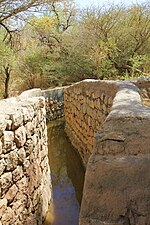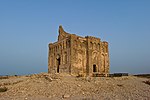List of World Heritage Sites in Oman
The United Nations Educational, Scientific and Cultural Organization (UNESCO) designates World Heritage Sites of outstanding universal value to cultural or natural heritage which have been nominated by signatories to the 1972 UNESCO World Heritage Convention.[1] Cultural heritage consists of monuments (such as architectural works, monumental sculptures, or inscriptions), groups of buildings, and sites (including archaeological sites). Natural features (consisting of physical and biological formations), geological and physiographical formations (including habitats of threatened species of animals and plants), and natural sites which are important from the point of view of science, conservation or natural beauty, are defined as natural heritage.[2] Oman accepted the convention on 6 October 1981, making its historical sites eligible for inclusion on the list. It has five World Heritage Sites and a further seven sites on the tentative list.[3]
The first site listed in Oman was the Bahla Fort in 1987, while the most recent one was the Ancient City of Qalhat in 2018. All five sites are listed for their cultural significance. Bahla Fort was listed as endangered in 1988 because of the degradation of the structure. In 2004, after reconstruction, it was removed from the endangered list.[4] Oman has served on the World Heritage Committee three times.[3]
World Heritage Sites[edit]
UNESCO lists sites under ten criteria; each entry must meet at least one of the criteria. Criteria i through vi are cultural, and vii through x are natural.[5]
| Site | Image | Location (governorate) | Year listed | UNESCO data | Description |
|---|---|---|---|---|---|
| Bahla Fort | 
|
Ad Dakhiliyah | 1987 | 433; iv (cultural) | The large mudbrick fort and the adjacent small oasis settlement date to the late Middle Ages, between the 12th and 15th centuries, and were constructed by the Banu Nebhan tribe. Bahla was the centre of Ibadi Islam. The fort is a pre-gunpowder building with round watchtowers and castellated parapets. Due to deterioration of the structure, the site was listed as endangered in 1988. Upon reconstruction, it was removed from the endangered list in 2004.[4] |
| Archaeological Sites of Bat, Al-Khutm and Al-Ayn | 
|
Al Dhahirah | 1988 | 434; iii, iv (cultural) | This site comprises three clusters of ancient necropolises and settlements from the Early Bronze Age, in the 3rd millennium BCE. During that period, the area was important for extraction of copper which was exported to Mesopotamia and possibly to the Indus Valley. The earliest constructions are in mudbrick while later are made with cut stone. Tombs from different periods have different styles. There are beehive tombs, dry-stone cairn tombs, small single-chambered, and elaborate multi-chambered tombs. A mound at Al-Ayn is pictured.[6] |
| Land of Frankincense | 
|
Dhofar | 2000 | 1010; iii, iv (cultural) | Frankincense, resin of the Boswellia sacra tree (pictured), was one of the most important luxury items of the Classical antiquity. This site comprises Wadi Dawkah where frankincense was collected, a trading post and caravan supply station at Shisr, and ports of Khor Rori and Al-Baleed which were heavily fortified. Khor Rori started to decline in the 5th century while Al-Baleed lost its role with the arrival of European trade in the 15th century.[7] The site was originally listed as The Frankincense Trail but renamed to its present name in 2005.[8] |
| Aflaj Irrigation Systems of Oman | 
|
Ad Dakhiliyah, Al Batinah, Ash Sharqiyah South | 2006 | 1207; v (cultural) | Aflaj is a traditional irrigation system in Oman that has been in use since at least the year 500. Groundwater or spring water is collected and delivered through a series of underground or surface channels to the settlements for domestic or agricultural purposes. The enclosed settlements, forts, palaces, watchtowers, and temporary dwellings used during the date harvest shape the cultural landscape that was made possible by irrigation of this otherwise harsh and very dry desert land. There are around 3,000 functioning aflaj systems in Oman that still provide a large part of the water used in the country. The World Heritage Site comprises five representative sites, Falaj Daris is pictured.[9] |
| Ancient City of Qalhat | 
|
Ash Sharqiyah South | 2018 | 1537; i, iii (cultural) | Qalhat flourished as the secondary capital of the Kingdom of Hormuz between the 11th and 16th centuries. It was a major trading hub for dates, Arabian horses, pearls, and incense, with trade routes extending to India, China, and East Africa. The city was attacked by the Portuguese in the 16th century and abandoned afterwards. The site comprises the remains of the city, its fortifications, and necropolises. Bibi Maryam mausoleum is pictured.[10] |
Tentative list[edit]
In addition to sites inscribed on the World Heritage List, member states can maintain a list of tentative sites that they may consider for nomination. Nominations for the World Heritage List are only accepted if the site was previously listed on the tentative list.[11] Oman lists seven properties on its tentative list.[3]
| Site | Image | Location (governorate) | Year listed | UNESCO criteria | Description |
|---|---|---|---|---|---|
| The forts of Rostaq and al-Hazm | 
|
Al Batinah South | 1998 | (cultural) | Located in a large oasis, the fort at Rustaq dates to the preislamic period when it was an important market place. Later additions include four towers and outer walls (pictured). There are several ancient houses remaining, as well as a funerary mosque. The Al Hazm Castle dates to the 18th century. It was built under the Yaruba dynasty. It is a rectangular two-storey structure with a narrow inner courtyard.[12][13] |
| Al Hallaniyyat Islands Proposed Nature Reserve | 
|
Dhofar | 2013 | x (natural) | The islands are barren with sparse Tamarix and Acacia trees. The surrounding sea is rich in corals and is home to numerous fish species, as well as dolphins and whales. The sandy beaches are important grounds for loggerhead sea turtles and green turtles to lay their eggs. There are numerous bird species, such as the masked booby, Audubon's shearwater, and red-billed tropicbird nesting on the islands as there are no predators.[14] |
| Bar al Hakman Proposed Nature Reserve | Al Wusta | 2013 | x (natural) | Bar al Hakman peninsula has sandy dunes, mudflats, mangrove forests, and marine habitats with seagrass meadows and coral reefs. The area is important for migratory birds that gather here in winter in large numbers, with 140 species reported. It is also important for sea turtles that lay their eggs here.[15] | |
| Smahan's Mountain Nature Reserve | Dhofar | 2013 | vii, x (natural) | The reserve is the largest protected area in the country. The rugged terrain comprises plateaus, canyons, wadis, and escarpments. The area is home to the critically endangered Arabian leopard and Dhofar shrew, as well as the Nubian ibex, Arabian gazelle, and caracal.[16] |
See also[edit]
References[edit]
- ^ "The World Heritage Convention". UNESCO World Heritage Centre. Archived from the original on 27 August 2016. Retrieved 21 September 2010.
- ^ "Convention Concerning the Protection of the World Cultural and Natural Heritage". UNESCO World Heritage Centre. Archived from the original on 1 February 2021. Retrieved 3 February 2021.
- ^ a b c "Oman". UNESCO World Heritage Centre. Retrieved January 8, 2024.
- ^ a b "Bahla Fort". UNESCO World Heritage Centre. Retrieved January 8, 2024.
- ^ "UNESCO World Heritage Centre – The Criteria for Selection". UNESCO World Heritage Centre. Archived from the original on 12 June 2016. Retrieved 17 August 2018.
- ^ "Archaeological Sites of Bat, Al-Khutm and Al-Ayn". UNESCO World Heritage Centre. Retrieved 8 January 2024.
- ^ "Land of Frankincense". UNESCO World Heritage Centre. Retrieved January 8, 2024.
- ^ "Decision 29 COM 8B.2 Changes to Names of Properties (The Land of Frankincense)". UNESCO World Heritage Centre. Retrieved 8 January 2024.
- ^ "Aflaj Irrigation Systems of Oman". UNESCO World Heritage Centre. Retrieved 8 January 2024.
- ^ "Ancient City of Qalhat". UNESCO World Heritage Centre. Retrieved 8 January 2024.
- ^ "Tentative Lists". UNESCO World Heritage Centre. Archived from the original on 1 April 2016. Retrieved 7 October 2010.
- ^ "Travel Oman: Visit Al Hazm Castle in Rustaq". Times of Oman. Retrieved 3 May 2024.
- ^ "The forts of Rostaq and al-Hazm". UNESCO World Heritage Centre. Retrieved 3 May 2024.
- ^ "Al Hallaniyyat Islands Proposed Nature Reserve". UNESCO World Heritage Centre. Retrieved 3 May 2024.
- ^ "Bar al Hakman Proposed Nature Reserve". UNESCO World Heritage Centre. Retrieved 3 May 2024.
- ^ "Smahan's Mountain Nature Reserve". UNESCO World Heritage Centre. Retrieved 3 May 2024.



